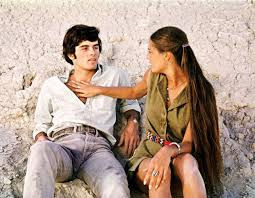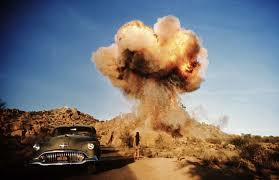 What happens when Italy's most pretentious director makes a movie about American counterculture? Try Michelangelo Antonioni's Zabriskie Point (1970), whose artistic and ideological miscarriages have baffled and fascinated critics for 46 years. It's a beautifully shot mess far less meaningful than it pretends.
What happens when Italy's most pretentious director makes a movie about American counterculture? Try Michelangelo Antonioni's Zabriskie Point (1970), whose artistic and ideological miscarriages have baffled and fascinated critics for 46 years. It's a beautifully shot mess far less meaningful than it pretends.Radical student Mark (Mark Frechette) flees Los Angeles after being mixed up in a protest that causes a policeman's death. He hijacks a plane and flies it to Death Valley, where he meets Daria (Daria Halperin), the teenaged secretary of Phoenix land developer Lee Allen (Rod Taylor). The two fall for each other, debating politics and making love. While Daria reconsiders her bourgeois lifestyle, Mark undertakes a desperate mission to stick it to the Man.
Zabriskie Point's charms are mostly surface - but what surface! Always a striking image-maker, Antonioni and photographer Alfio Contini grace the screen with amazing widescreen photography. Mark and Daria's frolics in the Valley are remarkable, with ageless canyons and swirling dust storms dwarfing the lovers into insignificance. Between Zabriskie's landscapes, Pink Floyd's jolting, dissonant soundtrack and the lingering set pieces without dialogue, the movie's atmospheric enough to warrant watching.
Unfortunately, Antonioni trades his usual opacity for ham-fisted obviousness. To comment on American capitalism, he shows montages of corporate logos and a TV ad using mannequins instead of people. He captures political ferment with rambling rap sessions (shades of Billy Jack!), stock footage of protests and trite symbology, like Mark's red shirt fluttering in the air or a cop misspelling "Carl Marx." Clever moments, like Mark bypassing gun laws by claiming he needs to protect against blacks, prove fleeting.
 When Antonioni's not stultifying, he's silly. Zabriskie's major set piece is a prolonged sex scene, where Mark and Daria's wild, dusty lovemaking degenerates into a hallucinatory orgy. Their lust unleashes the elemental forces of Earth and Love, causing mystical couples to materialize from the landscape, joining in a seemingly endless ode to hedonism. Too overwrought to arouse, too dumb to offend, it's the ultimate in symbolic excess.
When Antonioni's not stultifying, he's silly. Zabriskie's major set piece is a prolonged sex scene, where Mark and Daria's wild, dusty lovemaking degenerates into a hallucinatory orgy. Their lust unleashes the elemental forces of Earth and Love, causing mystical couples to materialize from the landscape, joining in a seemingly endless ode to hedonism. Too overwrought to arouse, too dumb to offend, it's the ultimate in symbolic excess.Mark Frechette and Daria Halprin were non-professional actors flitting around the fringes of the subculture; Frechette made a handful of other movies (notably Francesco Rosi's Many Wars Ago) before imprisonment and an early death, while Halprin was a psychologist who'd appeared in Jack O'Connell's documentary Revolution. Both stars are young, pretty and earnest, but not much else; for all the Marxist jargon they spout, they're as vapid and empty as the movie's messaging.
Professional actors Rod Taylor, G.D. Spradlin and Paul Fix inject moments of authority that seem strangely misplaced. Taylor's stuck playing a corporate greed head happy to rape and pillage the land around him. In one of his earliest roles, Spradlin deploys the oily, unctuous charm he'd employ in The Godfather Part II and elsewhere. Fix, a Western veteran, is perfectly cast as a codger bemoaning the landscape's development.
Zabriskie Point ends with absurdity, as Daria appears to harness her mind power to blow up Lee's condos. Nicolas Roeg and Pier Paolo Pasolini, on their wildest days, wouldn't dream of something so asinine. Perhaps Antonioni felt obligated, in his Hollywood debut, to provide an explosive climax without compromising his artistic vision. Since that vision's as clear as a glass of chocolate milk, he shouldn't have bothered.

